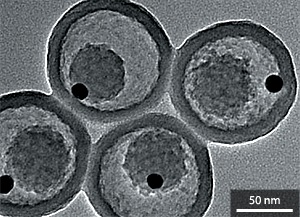
Transmission electron microscopy image of a mesoporous silica nanorattle (mesoporous shell and solid silica core)
containing a gold nanoparticle (black spot in this image).
© 2010 Wiley-VCH
‘Nanorattles’ consisting of a mesoporous shell and gold nanoparticle core can now be synthesized through a simple, efficient and controllable process.
Rattle-type nanoparticles consist of a spherical shell encapsulating a freely moving core particle in solvent. Several rattle-type structures have been prepared in previous research, including some in which the core is a metal nanoparticle and the shell is a mesoporous material. Such ‘nanorattles’ are of interest because the mesoporous shell allows small molecules to pass into the rattle’s internal space to react with the trapped metal nanoparticle. Existing methods to prepare these metal core–mesoporous shell materials, however, have typically involved multistep or low-efficiency procedures.
Fangqiong Tang and colleagues from the Chinese Academy of Sciences and the Beijing Creative Nanophase Hi-Tech Company Limited in Beijing have now devised a simple and efficient method for making silica nanorattles housing a gold nanoparticle1. Their approach allows the size of the encapsulated gold nanoparticles to be controlled by varying the reaction conditions, such as reactant concentration, reaction time and temperature.
The researchers produced their gold-functionalized nanorattle by immersing hollow mesoporous silica nanospheres with a solid inner silica core in a solution of tetrachloride aurate (HAuCl4) and then heating. Reactive alkylamino groups left in the core of the nanosphere as a result of the nanorattle preparation process served as reducing agents and stabilizers for the growth of a gold nanoparticle inside the shell. In this procedure, the nanorattle effectively acts as a nanoreactor for the controllabe formation of the gold nanoparticle.
The researchers showed that this hybrid nanomaterial has high catalytic activity and good reusability for the reduction of aromatic nitro compounds to their corresponding amino derivatives. The scope of the researchers’ new method for creating nanomaterials for other applications is potentially vast. “By controlling the shape and composition of the core inside the silica nanorattles, these types of structures could be used in plasmonics, sensing and imaging,” says Tang.
The future focus of the work, according to Tang, will be the synthesis of a variety of functional nanorattle structures, including the preparation of gold cores of different shapes. The incorporation of cores of differing composition may result in various optical and magnetic properties. “A silica nanorattle with a magnetic core could have potential biomedicine applications, such as drug delivery, intracellular imaging and magnetic resonance imaging.”Transmission electron microscopy image of a mesoporous silica nanorattle (mesoporous shell and solid silica core) containing a gold nanoparticle (black spot in this image).
© 2010 Wiley-VCH
(Source from NPG Asia Materials http://www.natureasia.com/asia-materials/highlight.php?id=802) |

